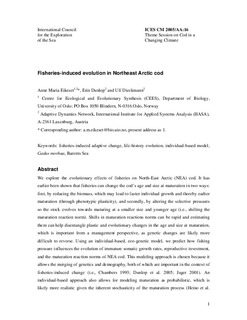| dc.contributor.author | Eikeset, Anne Maria | |
| dc.contributor.author | Dunlop, Erin S. | |
| dc.contributor.author | Dieckmann, Ulf | |
| dc.date.accessioned | 2012-02-07T09:09:06Z | |
| dc.date.available | 2012-02-07T09:09:06Z | |
| dc.date.issued | 2005 | |
| dc.identifier.citation | This report is not to be quoted without prior consultation with the General Secretary. | no_NO |
| dc.identifier.uri | http://hdl.handle.net/11250/103689 | |
| dc.description | Keywords: fisheries-induced adaptive change, life-history evolution, individual-based model,
Gadus morhua, Barents Sea | no_NO |
| dc.description.abstract | We explore the evolutionary effects of fisheries on North-East Arctic (NEA) cod. It has
earlier been shown that fisheries can change the cod’s age and size at maturation in two ways:
first, by reducing the biomass, which may lead to faster individual growth and thereby earlier
maturation (through phenotypic plasticity), and secondly, by altering the selective pressures
so the stock evolves towards maturing at a smaller size and younger age (i.e., shifting the
maturation reaction norm). Shifts in maturation reactions norms can be rapid and estimating
them can help disentangle plastic and evolutionary changes in the age and size at maturation,
which is important from a management perspective, as genetic changes are likely more
difficult to reverse. Using an individual-based, eco-genetic model, we predict how fishing
pressure influences the evolution of immature somatic growth rates, reproductive investment,
and the maturation reaction norms of NEA cod. This modeling approach is chosen because it
allows the merging of genetics and demography, both of which are important in the context of
fisheries-induced change (i.e., Chambers 1993; Dunlop et al. 2005; Jager 2001). An
individual-based approach also allows for modeling maturation as probabilistic, which is
likely more realistic given the inherent stochasticity of the maturation process (Heino et al.
2
2002b). Effects of climate fluctuations and climate change are expected to affect recruitment,
but at this moment these effects have not yet been included in the model. Hence, an important
extension of this work will be to consider the large changes in the Barents Sea climate
predicted to occur towards the middle of the 21st century. | no_NO |
| dc.language.iso | eng | no_NO |
| dc.publisher | ICES | no_NO |
| dc.relation.ispartofseries | ICES CM documents;2005/AA:16 | |
| dc.subject | arctic cod | no_NO |
| dc.subject | arktisk torsk | no_NO |
| dc.subject | climate change | no_NO |
| dc.subject | klimaendringer | no_NO |
| dc.subject | Barents Sea | no_NO |
| dc.subject | Barentshavet | no_NO |
| dc.title | Fisheries-induced evolution in Northeast Arctic cod | no_NO |
| dc.type | Working paper | no_NO |
| dc.subject.nsi | VDP::Agriculture and fishery disciplines: 900::Fisheries science: 920::Resource biology: 921 | no_NO |
| dc.source.pagenumber | 4 s. | no_NO |
